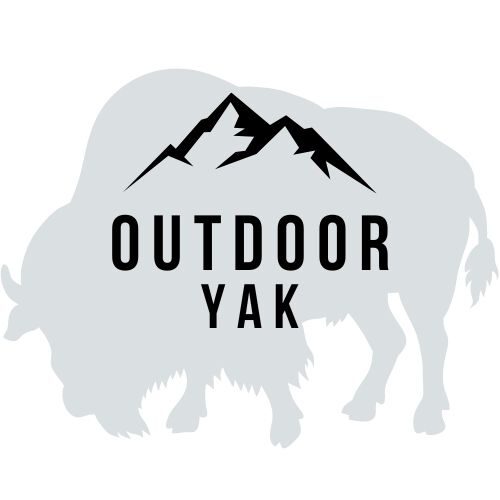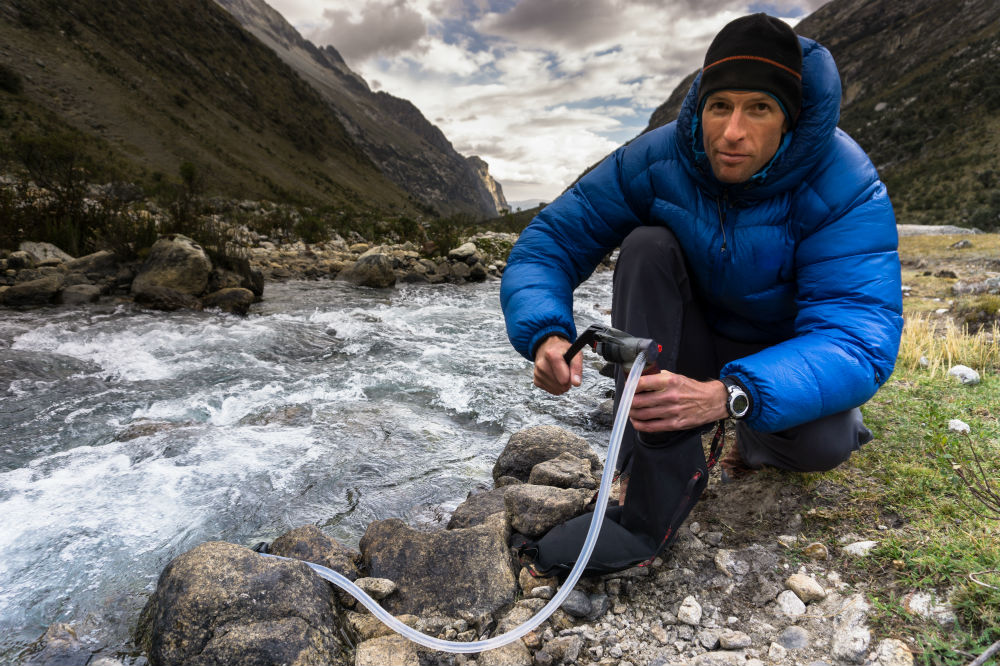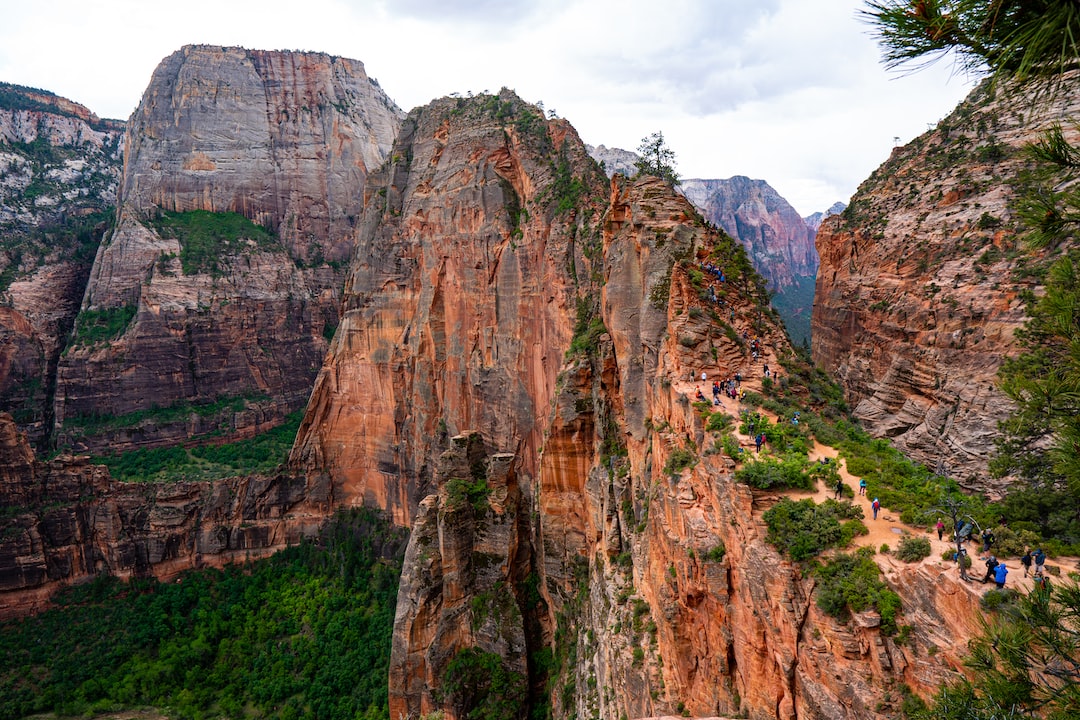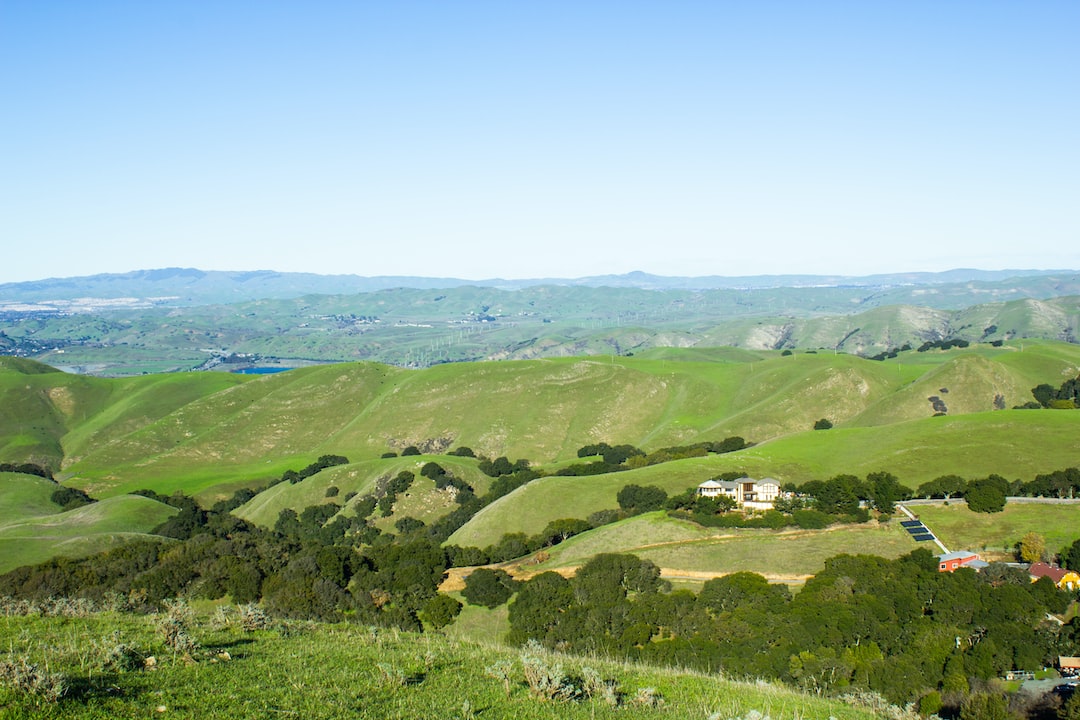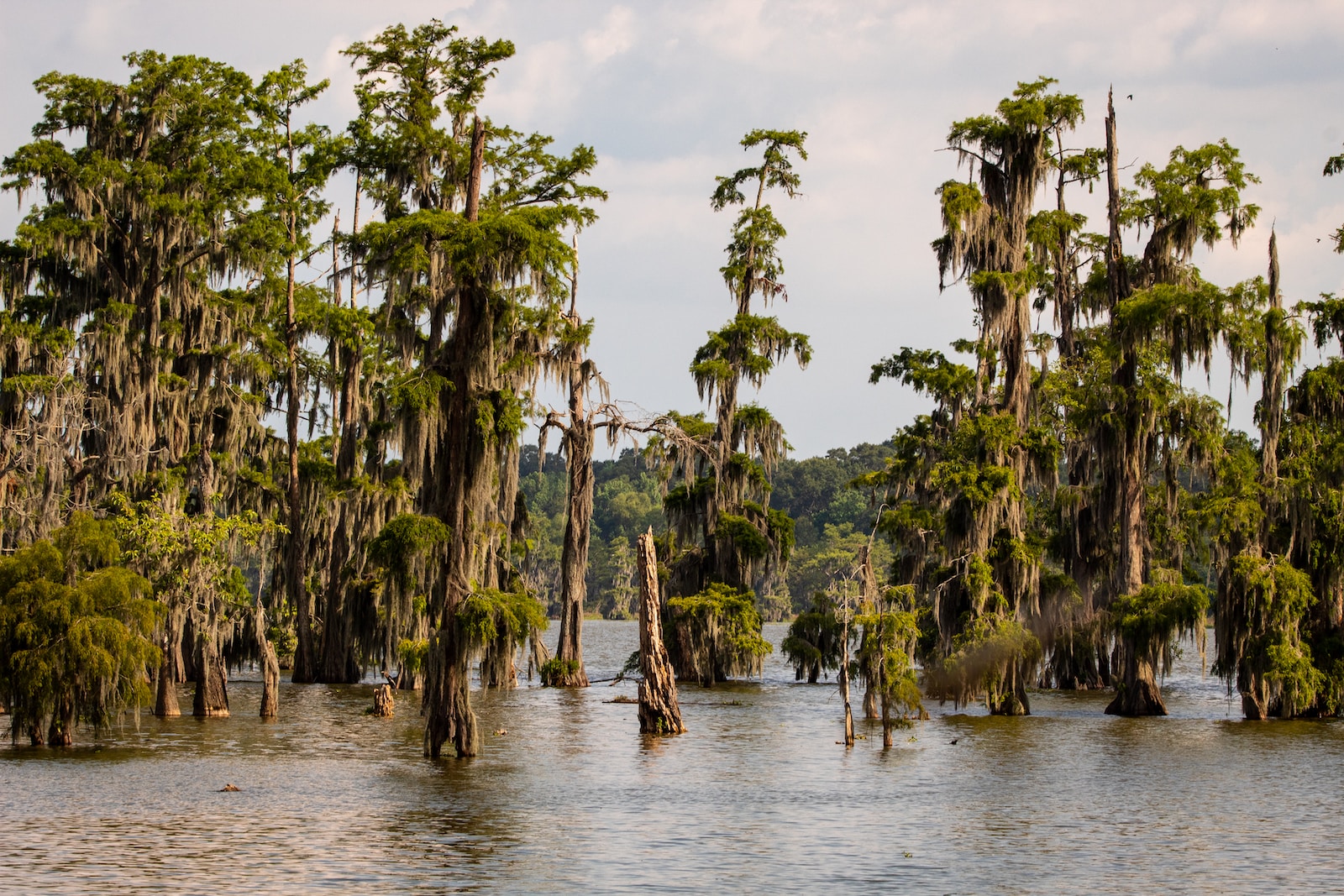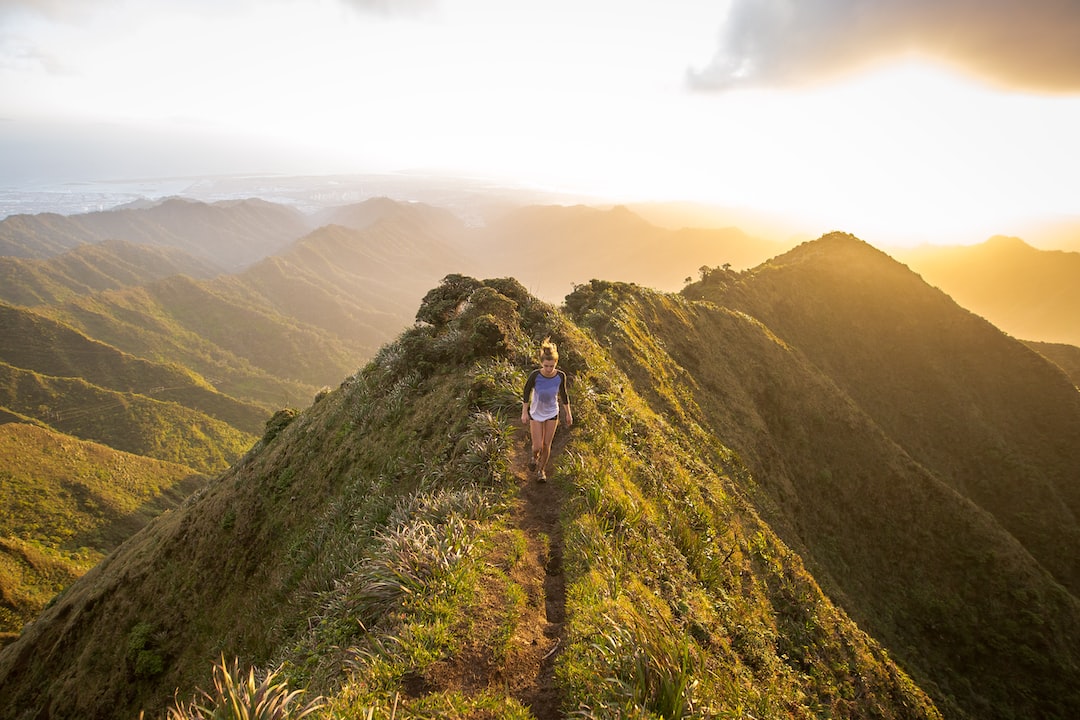Clean water. You can’t live for long without it. It’s essential for the human body and getting sick from contaminated water is an ever-present concern. Whether you’re venturing to your local national park creek or climbing mountains in far-flung places – having a reliable & lightweight water purifier by your side is a life-saver (quite literally).
In this guide, I’ve done the hours of research of the absolute best lightweight water purifiers for backpacking, trekking and travel adventures around the world.
1. Platypus GravityWorks 4L
Best Overall Water Filter for Backpacking
The Platypus GravityWorks4 is a lightweight high-capacity water purifier that now a staple for backpackers and campers. It removes 99.9% all bacteria and filters 1 gallon (4l) iters of water ready for cooking or drinking in 2.5 minutes.
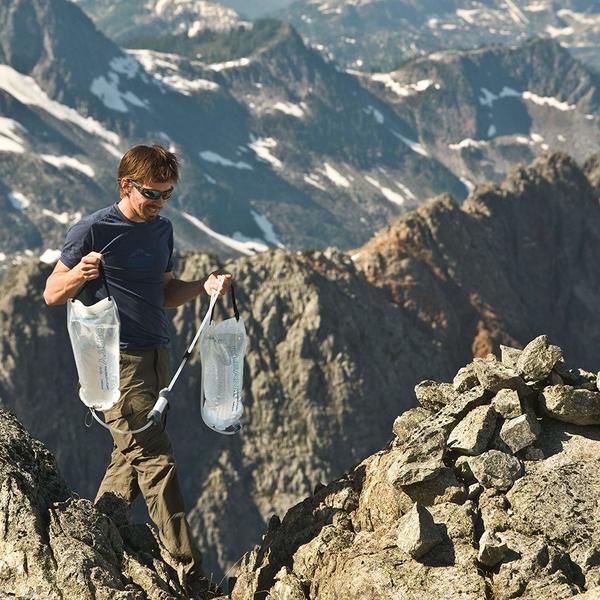 To filter the water you need to raise the bags with your hands or hook them to a tree for the connected pipe to work its magic. It’s easy to get the hang of it and it works using gravity rather than a hand pump. The system is pretty ingenious and you start by filling one container and letting it hang – the hollow microfiber hoses does the filtering and transfers the clean drinking water into the other bag.
To filter the water you need to raise the bags with your hands or hook them to a tree for the connected pipe to work its magic. It’s easy to get the hang of it and it works using gravity rather than a hand pump. The system is pretty ingenious and you start by filling one container and letting it hang – the hollow microfiber hoses does the filtering and transfers the clean drinking water into the other bag.
The cartridges are replaceable and you’ll get about 1,500 gallons (5,678 liters) before you need to replace them. The system packs away nicely and weighs just 11.5 ounces (326 grams) when it’s empty.
While the Platypus is not the cheapest option (nor is it too expensive for what you get), based on how good it is at filtering water and it’s versatility for hikes and multi-day adventures – it’s got out accolade of the best overall filter for backpacking and camping.
Awesome features worth mentioning:
- Lightweight portable filter that delivers 1 gallon (4l) of fresh water in 2.5 minutes.
- Handles an impressive 11,500 gallons (5,678 liters) of water before you need to change the replaceable cartridges which are around $40-50.
- Let gravity do the work – no hand pumping required.
- Strong bags that are easy to transport, fil and empty. Great for solo packers, couples, and small groups.
Downsides
- You need to hang it or hold it for 2.5 minutes – no biggie.
- It’s a big apparatus that may produce too much water for just one person looking for a smaller setup or day hike kit.
Where to buy?
2. MSR MiniWorks Ex Microfilter
The Miniworks EX Microfilter is a pump water filtration system for adventure travelers and backpackers. It’s a smaller (and cheaper) version of the MSR Guardian Purifier System which is typically overkilled for most backpackers trekking in low-medium risk areas.
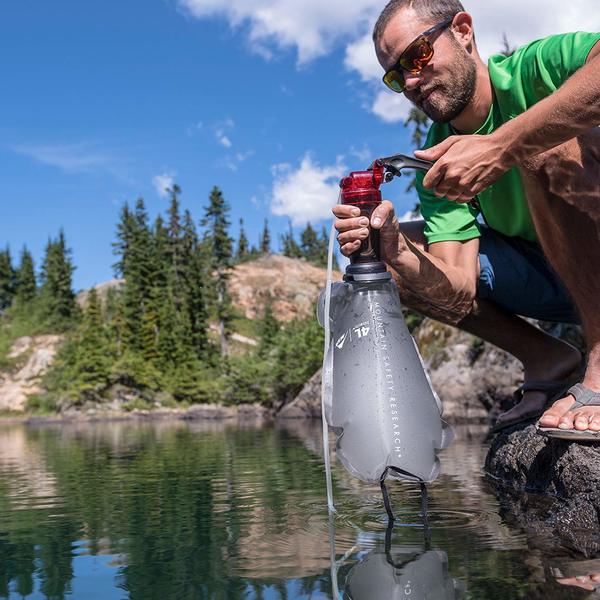 The Miniworks is a very popular pump and it does a great job of being lightweight, versatile but able to filter through a decent amount of water in a short space of time. While it’s a bit heavier than the Katadyn filter, it does have a much longer filter lifespan of 2,000 liters (528 gallons).
The Miniworks is a very popular pump and it does a great job of being lightweight, versatile but able to filter through a decent amount of water in a short space of time. While it’s a bit heavier than the Katadyn filter, it does have a much longer filter lifespan of 2,000 liters (528 gallons).
To work the filter you’ll need to pump the system for 1 minute before feeding water into the filter – this helps clean out old particles and make sure it’s properly filtering out new water you feed into it. Once that’s done you’ll get about 1 liter of filtered water with every 60-80 pumps (1 minute).
The purifier uses a ceramic filter that is effective at removing bacteria, organic compounds and particulates (which will not only make the water safe, but also give it a better taste). While it can get clogged up with very dirty water – the filter is easy to clean and can be relied upon to give your clean drinking water for your entire backpacking trip. Just take out the ceramic filter when you get home to dry out.
The pump is made in the USA and is backed with a lifetime warranty – making it well worth its price tag. You’ll get plenty of camping and hiking adventures out of this system for many years to comes.
Awesome features worth mentioning:
- Lightweight system weighs just 456 grams (1 pound) that gives you 1 liter per minute of fresh drinking water (about 85 pumps a liter).
- 2,000-liter cartridge lifespan which gives you plenty of water before replacing.
Downsides
- Heavier and a bit slower to pump than the Katadyn
Where to buy?
Best Ultralight Water Filter
3. Sawyer Squeeze Mini Water Filter
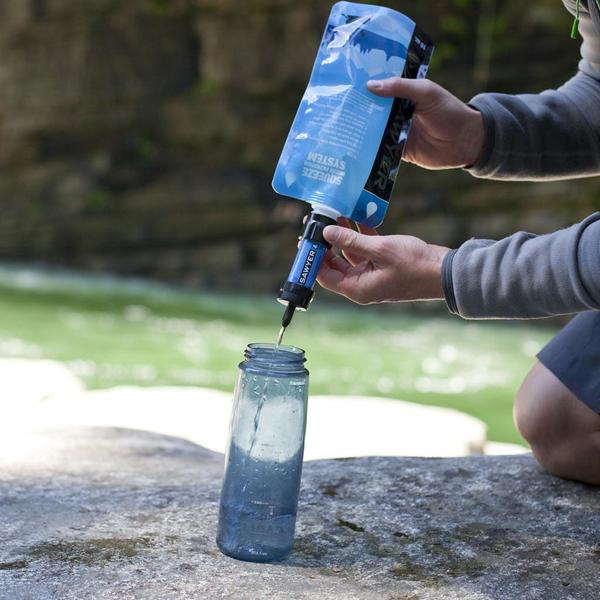 The Sawyer Mini Water Filtration system is a lightweight, extremely versatile system that can filters out a massive amount of water – more than you’re likely to ever use over the course of your lifetime. The Sawyer can handle an impressive 100,000 gallons (378,000 liters) of water which is huge when you compare it to the LifeStraw that does just 264 gallons (1,000 liters).
The Sawyer Mini Water Filtration system is a lightweight, extremely versatile system that can filters out a massive amount of water – more than you’re likely to ever use over the course of your lifetime. The Sawyer can handle an impressive 100,000 gallons (378,000 liters) of water which is huge when you compare it to the LifeStraw that does just 264 gallons (1,000 liters).
The Sawyer is impressive because it is able to filter so much water for such a cheap price. While it’s not as easy to use and doesn’t have the flow rate of systems like the larger Platypus – for solo backpackers or those on a budget it does the job very well.
If you want a faster filter and an easier setup then other options might be worth looking at – but expect to pay more. If you want an incredibly cheap, effective filter that is lightweight and can filter more water than you’re likely to ever need, the go for the Sawyer.
Just remember to flush it everytime you use it to keep it clean otherwise it can clog up.
Awesome features worth mentioning:
- Massive 100,000 gallons (378,000 liters) of water of use – lifetime supply.
- Hollow fiber filter will remove 99.99999% of bacteria.
- Lightweight system easy to pack away and travel with – it weighs just 85 grams (3 ounces).
- Inexpensive and very cheap cost per liter over the filter’s lifespan.
Downsides
- Syringe section is susceptible to freezing in sub-zero conditions (keep it in a jacket pocket).
- Requires a bit more effort to setup than gravity or pump systems and delivers water a slower flow rate.
Where to buy?
Best of the Rest
4. Katadyn Hiker Microfilter
The Kayadyn is an enclosed pump system that is very reliable and works well for most backpacking situations from day hikes to multi-day backcountry adventures.
It’s easy to use and has less moving parts than other systems – to get going you put the hose end in the water, screw the other end into the container and then start pumping. You’ll get roughly 1 liter per minute and the pump action is smoother and faster than the MSR MiniWorks.
It’s a well-built pump but the filter will need replacing every 750 liters (200 gallons) and it costs around about $50. Despite the shorter lifespan compared to other systems the pumping is smoother and easier to use and the carbon filter makes water taste better.
The filter comes with a compact carry bag but the hydration bladders are sold separately – otherwise, the 1/4 inch connector will fit into most bottles and containers.
Awesome features worth mentioning:
- Very easy setup and pump action – 1 liter per minute.
- Activated carbon absorbs more particles and makes the water taste better.
- Very low maintenance – no need to constantly backflush the system.
- 0.2-micron glass fiber filter removes bacteria and small particles.
Downsides
- Pretty short filter lifespan (due to the carbon filter).
Where to buy?
5. MSR TrailShot Micro-Filtration System
MSR TrailShot Water Filter is an ultra lightweight pipe filter that is 15cm long uses a 0.2 micro filter that can deliver 1 liter of water every minute using a one-handed pump action.
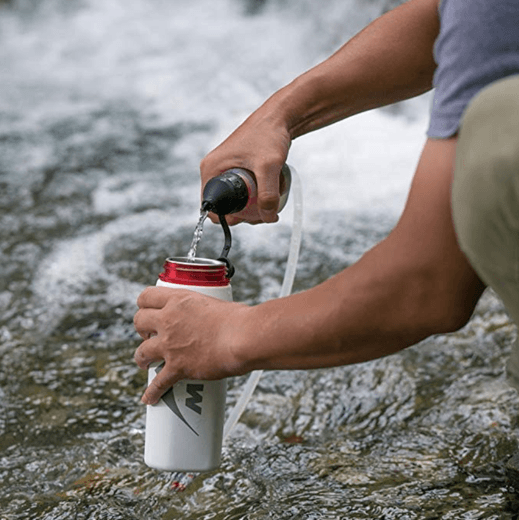 It’s twice as light as the Katadyn above and small enough to fit inside your jacket pocket – which makes it great for trail runners and day hikers. Despite the minimalist design the flow rate matches up well to other systems and does work well in shallow water sources like slow running streams and pools. You’ll get 2,000 liters (528) of water out of this system
It’s twice as light as the Katadyn above and small enough to fit inside your jacket pocket – which makes it great for trail runners and day hikers. Despite the minimalist design the flow rate matches up well to other systems and does work well in shallow water sources like slow running streams and pools. You’ll get 2,000 liters (528) of water out of this system
There are even lighter systems, but the Trailshot has a great mix of flow rate speed and smooth pump action – which makes it a top choice for solo backpackers on shorter trips. For extended trips or groups of trekkers, a larger system like the Sawyer Squeeze offers more without weighing you down too much.
If you want a straightforward, well designed lightweight system for shorter backcountry adventures then the TrailShot is a great choice – you can suck directly from the source of fill up a water bottle for later.
Awesome features worth mentioning:
- Weighs just 142 grams (5 ounces).
- Very easy to use one-handed pump action gives you 1 liter a minute.
- Works well in shallow streams and allows you to filter water without getting cold hands (Sawyer Squeeze) or laying on the ground (LifeStraw).
Downsides
- Shorter filter life.
Where to buy?
6. Grayl Ultralight Water Purifier Bottle
The Grayl is a very simple and clever water purifier bottle. It’s straightforward and easy to get set up. Simply fill it with water and then use the french-press style plunger to force the water through the filter and it’s ready to drink.
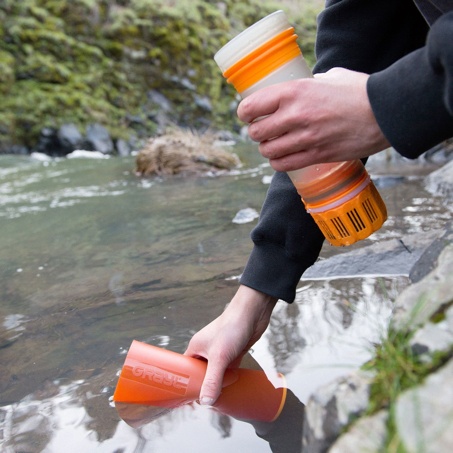
It’s quick and efficient and you’ll get half a liter out of each press. Which isn’t bucket loads but enough for a few hours of hiking. It’s great for on the go drinking and topping up your reserves – but not as a standalone for longer trips – as it relies on a ready supply of water to keep pressing. Alternatively, you can carry ‘dirty’ water with you in other bottles and put it into the Grayl as you need it.
The filters are replaceable and use carbon activation to absorb more particles than traditional filters – which makes some water taste a bit nicer.
The lifespan of the purifier has a lifespan of 150 liters which is lower than other options on this list – but it is a purifier, not just a filter which means as well as getting rid of bacteria, protozoa, and particles it will also filter out viruses. Which makes this a great option for higher risk areas, international travel and as a replacement for buying water in disposable plastic bottles.
Awesome features worth mentioning:
- Quick, no messing filter. Fill, press and drink.
- Half a liter in 15 seconds, very convenient – get sipping without taking your pack off.
- Filters our bacteria and particles using an activated carbon filter.
Downsides
- Doesn’t hold much water.
- The filter needs replacing every 150 liters – filters are replaceable.
Where to buy?
7. Potable Aqua Pure Electrolytic Purifier
This system creates a oxidant disinfectant from salt using electricity, which completely purifies the water making it safe to drink in 30 minutes (4 hours for combating Cryptosporidium). It’s a USB rechargeable kit that also comes with a solar charger for when you’re in the outback with no electricity and for emergencies.
It’s a one-button system which is very easy to use which you can tap multiple times to signal the amount of water your looking to process. To work the system, open up the rubber cover and put in a small amount of salt solution (it comes with salt containers.) One that solution is ready simply empty it into your ‘dirty’ water container and wait 30 minutes and then its ready to drink.
This isn’t the most practical system for day hikes, but great for multi-day trips if you’re processing water for a small group of people and have the time in camp for the water to purify (you can start the process of creating the chlorine as you hike – the system is very small).
Awesome features worth mentioning:
- Comes with a USB and solar charger.
- Converts 60,000 liters (15,850 gallons) over its lifespan.
- Make bacteria and viruses inactive.
- Cost effective solution for processing lots of water.
Downsides
- Not practical for short hikes or when you don’t have time to wait for the chlorine to take effect.
- Some reviewers notice a chemical aftertaste (completely safe).
Where to buy?
8. LifeStraw Personal
The life straw is a famous invention that uses the power of suction to force dirty water directly from the source through the internal carbon activated filter and into your mouth.
It’s extremely lightweight, and perfect for solo backpackers looking for a personal backup and safety net. It’s a remarkable tool but there are a few downsides to be aware of: first, you need a dirty source of water and you’ll have to get down and dirty – lay on the floor to get the straw into the source. It also has no internal reservoirs – but if you combine it with another empty vessel – you can fill it with dirty water and drink it on the go as you need it.
Awesome features worth mentioning:
- Source to mouth carbon activated filter removes all bacteria and particles above 0.2 microns.
- Suction powered, limited moving parts and extremely easy to pack.
Downsides
- No storage compartment of fresh water.
Where to buy?
Water Purifier and Filter Buying Advice
Purification vs. Water Filtration
Although these terms are often used interchangeably, purifiers and water filters are not the same thing. They have a different level of protection against microorganisms from one another. Filters protect against bacteria and protozoa, while purifiers can filter our viruses as well – making them the better choice for international travel to far-flung places.
Recap: if you’re going to higher risk areas or drinking from dirtier water then you’ll be safer using a purifier whereas for most trips in low to medium risk areas a water filter will be just fine.
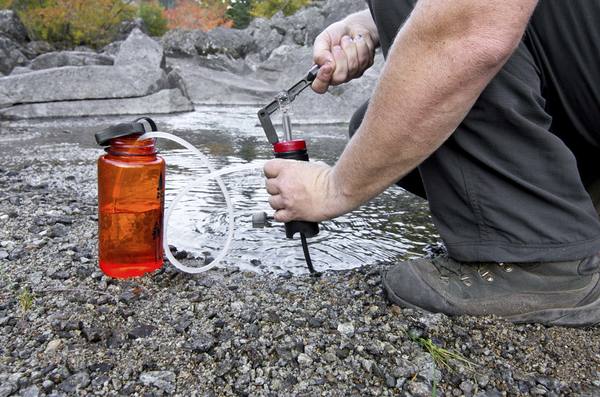
All About Water Purifiers
Water purifiers are a bit more advanced. As well as removing everything that water filters do, they also have the technology to weed out the much smaller and more deadly viruses (10-100x smaller than bacteria) that may be potentially lurking in your dirty water. They do this by using ultraviolet light, specific chemicals and/or tiny fibers that filter out even smaller particles.
If you’re traveling in places with more contaminated water or in developing countries then there is a higher chance of water bourne viruses being present – and so it makes sense to make use of a purifier rather than a typical filter.
While filters are better at removing particles from the water and purifiers are better at removing viruses, for some types of situation a combo of the two works well and some more expensive systems like the MSR Guardian do a great job at both.
Types of Purifiers and Water Filters
Gravity Filters
 These filters use the natural forces of gravity to push water through the filter from one container to the next. They’re the fastest and usually the easiest way of filtering water as they don’t require much or any manual labor – except for filling the dirty container and slinging them on a tree or holding them up.
These filters use the natural forces of gravity to push water through the filter from one container to the next. They’re the fastest and usually the easiest way of filtering water as they don’t require much or any manual labor – except for filling the dirty container and slinging them on a tree or holding them up.
Gravity filters work by using the downward force of gravity to transfer the dirty water in through the filter and out into the clean container. The Platypus- our top pick of the best backpacking filter is a gravity filter and it does an amazing job of producing 4 liters a minute. Because of there speed and effectiveness gravity filters are best suited for couples or small groups of backpackers looking to share the same water filter.
They produce plenty of water, enough for cooking and drinking in a short amount of time. The only downsides are that the systems are a bit bigger than the pump or straw systems as they will always need one section or bag for the dirty water and then another for the clean water to feed into.
While minimalist or solo backpackers may find gravity filters overkill, for extended trips or group tracks – the gravity filters are a great option. Bear in mind you’ll need a tree or a gradient to put the bags on (or you can just hold them) but other than that there are no real limitations to where you can use them.
Pump Filters/Purifiers
By far the most popular option, these filters use pumps to push the water supply through the filters and into the clean drinking water container. Pump filters have been around the longest and they’re an effective solution to moving the water through the filters. The pumping action pressurizes the water and pushes it through the microscopic filters into the clean end – ready for drinking and cooking.
The downsides are that unlike gravity systems they require a bit of manual labor to get going. Pumping with modern systems don’t take more than a few minutes to produce a decent amount of water, but you’ll still need to put in the work to get your reward.
Older filtering systems with inefficient pumps can be a bit arduous and require a bit more TLC and cleaning -but if you got the higher end models you’ll get all the benefits of a filter and purifier rolled into one.

Bottle Filters/Purifiers
These are smaller more compact systems that use the suction from your mouth to force water through the filters as you drink. You’ll get a lot less water, but plenty enough to drink straight from the bottle until your thirst is quenched.
Some systems allow you to squeeze the water into a receptible that can be stored for later while others are direct from the filter to mouth as you drink from the bottle.
Most bottle systems are filters, while some like the Grayl Ultralight act as both filters and purifiers and use a french press system – which will treat your water as compress the filter with one action – allowing you time to sip it through the bottle as you please. The only problem is that the filter life span is pretty short and the capacity not so great – making it a decent option for solo trekkers moving through higher risk areas looking for that extra protection to filter out viruses.
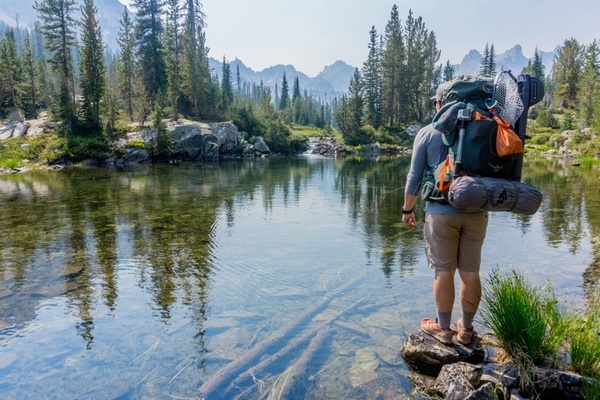
Straw Filters
Ultralightweight and perfect for the minimalist solo backpacker, trekker and day packer – straw filters are simple small tube filters that work through suction direct from the source to your lips.
Straw filters use tiny microscopic pores to filter out particles and bacteria – as water is sucked through the cartridge. Water filters are small but do an effective job at filtering out protozoa and bacteria (like Salmonella and E. Coli) – but you’ll need to apply lots of suction to get your reward.
Straw filters are great for drinking as you go, but won’t produce the volume of water you’ll need for cooking (aside from the fact of the practicality of getting it from your mouth to the pot!).
Highly contaminated water sources that may have human waste typically have viruses that the straw won’t protect against – so if this is of concern look for a more robust purifier gravity or pump system. For most trips in low-risk areas such as high mountain stream or snowmelt, you’ll be in good hands with a straw.
Straw filters are a lightweight cost-effective solution for drinking, but they don’t allow you to filter and store water for later – so rely on the presence of a water source to be readily available.
Chemical Purifiers
Tablets like iodine and chlorine dioxide drops provide an alternative method of cleaning water to make it safe to drink. Tablets are lightweight, cheap and get the job done. While the flavor of the water often has a more chemical taste to them – it will be safe to drink and fine for cooking with,
Tablets work by killing off and neutralizing bacteria and viruses in the water, but they won’t remove any particles. They’re highly effective and reliable but you’ll need to wait at least 30 minutes before drinking – which can be a pain if you’re thirsty or wanting to cook.
Many backpackers bring these as emergency backups for when they encounter dirtier looking water, or when the main filtration system breaks down. That said tablets and drops work best in cleaner water like glacial streams because they won’t remove any particulates or critters. If you have a spare pot you can move the water gently to another container after it has sat and the sediment has settled to the bottom – if you want to reduce the particles in your final drinking vessel.
UV Purifiers
Using UltraViolet light to destroy bacteria cells, UV filters work by shining a light onto your water as it swirls for about 1-2 minutes. These systems are great for low sediment water but the downsides are that they rely on battery power – rather than suction alone.
The advantage of UV is that there is no cartridge to replace, but like the tablet option, you’re not eliminating sediment.
Weight and Bulk
Weight saving is a key issue for backpackers and campers looking for reliable solutions that don’t weigh them down when exploring the backcountry. Filtration systems are getting lighter and lighter and on the ultralight end, we have tablets and drop – which take up no space and weigh very little.
The next stage is the ultralight straw filters which weigh around 2-3 ounces (56-85g) and take out sediment. Some require a readily available source of water while others have built-in water for some but limited storage.
The next and most popular option for extended trips is gravity or pump filtration systems which clean the water, remove bacteria and produce enough for cooking and drinking for a small group. Expect more weight and more space to be taken up but you’ll get the luxury of storage and plenty of fresh water to use throughout your backpacking trip.
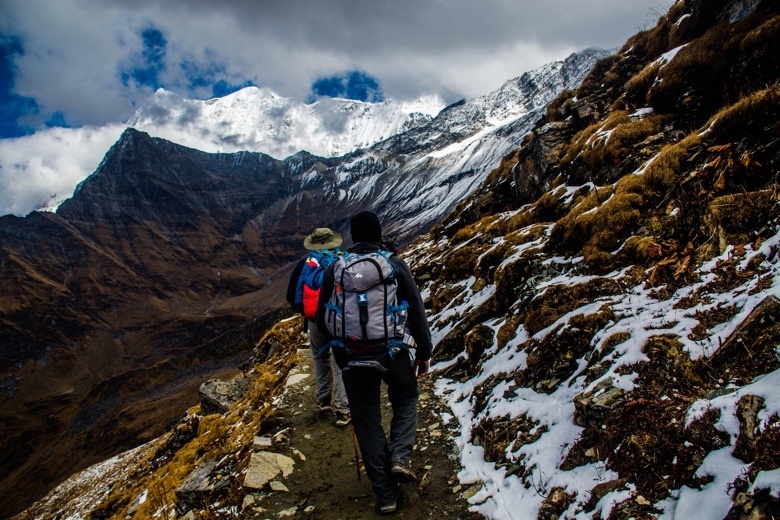
Filter Lifespan
Filters are not forever and eventually, the component parts will need replacing. There is only so much water a filter can handle before it gets clogged up with particles and no longer does an effective job at cleaning water.
Some filters like the Katadyn are cheaper than other rivals like the MSR but the cartridges have a shorter lifespan and can pump through less water before they need replacing. 750 vs 2,000 liters. The filters themselves are also 10% or so more expensive, which is worth considering if you making a decision between the two.
There is a massive gulf between some models, the high-end Sawyer Squeeze has a 1 million gallon guarantee while the Grayl purifying bottle has a cartridge life of just 150 liters.
Bear in mind that the filtering of the last liter is not going to be as fast as the first one, as with sediment built up comes a slow down in the flow rate. You should also know that the manufacturer recommendation for replacing the cartridges should be respected if you want to continue drinking clean water.
It’s worth calculating how often you’ll be using your filter each year, to give you an estimation of how many liters of water you’ll go through. It may be a lot more or a lot less than you might think and this can help you decide on the most cost-effective filter for you.
Flow Rate
How fast your filter can process dirty water into clean water depends a lot on the flow rate of the filter. The higher your filters flow rate the more water you can process and the easier it will be to full up your reserves and start cooking with.
You’re more likely to keep yourself hydrated if it is easier to process water through your filter. Having a large enough flow rate will save you time and allow you to share your water with more people in your group – allowing you to share the use of tilers rather than each of you having your own system. If your a solo backpacker or want to be prepared in an emergency then it’s a good idea to have a smaller backup option like tablets or a filter straw for when you’re on your own.
Gravity filters like the Platypus tend to have the highest flow rates – produce 4 liters in just 2 minutes or less. This is followed by pump filters that require some manual labor but will typically produce 1 liter per minute – the more expensive MSR Guardian works a purifier and filters an impressive 2.5 liters a minute (expect to pay a premium for this though).
Chemical purifier tablets don’t have a flow rate, but in terms of time, they’ll take about 30 minutes to take full effect, which is something worth factoring in – when it comes to gathering water.
As mentioned before, over time the flow rate will change as the cartridges near the end of its life due to sediment build up. A fresh cartridge is going to have the fastest flow rate and it will slowly diminish over time. Be sure to follow the recommendations for cleaning and taking care of your filter that you’ll find in the setup guide for each brand.
Pore Size
This refers to the size of the openings in the filter. The smaller the pores the less material can pass through and the better the filter or purifier is at blocking particles, bacteria and the much smaller viruses.
According to the CDC guide on water treatment, the pore measurements range from 0.05 to 5 microns. Purifiers are on the smaller end while filters are on the larger end of this scale – which different brands and systems using a range of pore technology and materials to capture foreign bodies that may be in the water.
Most backpacking filters will have a pore size of .1 to .2 microns which is able to combat protozoa, bacteria but not viruses. For protection against these smaller cells, you’ll need a system specifically marked as a purifier. Materials like carbon will absorb particles, whereas most filters will only filter our particles above a certain size. Substances like metals, salts, sugars, and chemicals, that have absorbed into the water will typically not be filtered out by most portable travel systems as they require more advanced tech to remove these.
Water taste
Most water filters just take our bacteria, protozoa and sometimes viruses and particles – but they won’t alter the taste of the water from its natural taste. So even though you’re using a filter it’s always best to seek out the cleanest looking water you can find. Preferably you want to find running water and the closer it is to its source the better – it means it will have fewer particles and be less likely to contain animal waste or human interference.
Chemical tablets, on the other hand, will usually give the water a slightly altered aftertaste (The Potable Aqua tablets are unique in that you can use a neutralizing tablet to remove much of this taste). Chemical filtration or UV pens won’t remove any particles from the water, which will make some water sources taste differently.
If you’re sensitive to taste, then pick a gravity or pump system over other filtration methods. Look for one like the LifeStraw Universal, Grayl Ultralight Purifier and MSR MiniWorks which contain carbon filters – carbon does a very good job of neutralizing compounds and making the water taste nicer. You can also get carbon add-ons for some models of filters like the Platypus GravityWorks. You should know that carbon has a shorter lifespan of six months or 200 liters (whichever comes first) – but if the taste is important to you or your water sources might be more contaminated it might be worth the extra expense.
Filter Maintenance/Replacement
Keeping your filtration and purifying system clean and well maintained will make sure it’s actually cleaning your water properly, more likely to last for the long haul and also deliver a reliable flow rate for your entire trip.
Over time particles build up inside the filters and the pipes and you’ll need to clean water through the filters to keep them maintained. For some systems like the LifeStraw it’s just a matter of blowing out after each drink – whereas for some like the pump systems like the MSR MiniWorks Ex Microfilter you’ll want to flush through water for a minute before filling your vessel.
Pump filters are a bit more high maintenance and you’ll need to unscrew the system, take out the filter and use a brush to clean the interior. Systems like the SteriPen or Potable Aqua tablets require a minimum or no maintenance – as there are no moving parts.
Each system is slightly different and has its own unique quirks and ways of maintaining it. Be sure to read the guide books that come with the system you choose and take the time to keep it well looked after – it will pay you back for the years to follow when you’re out on the trail and most need it.
Emergency Backups
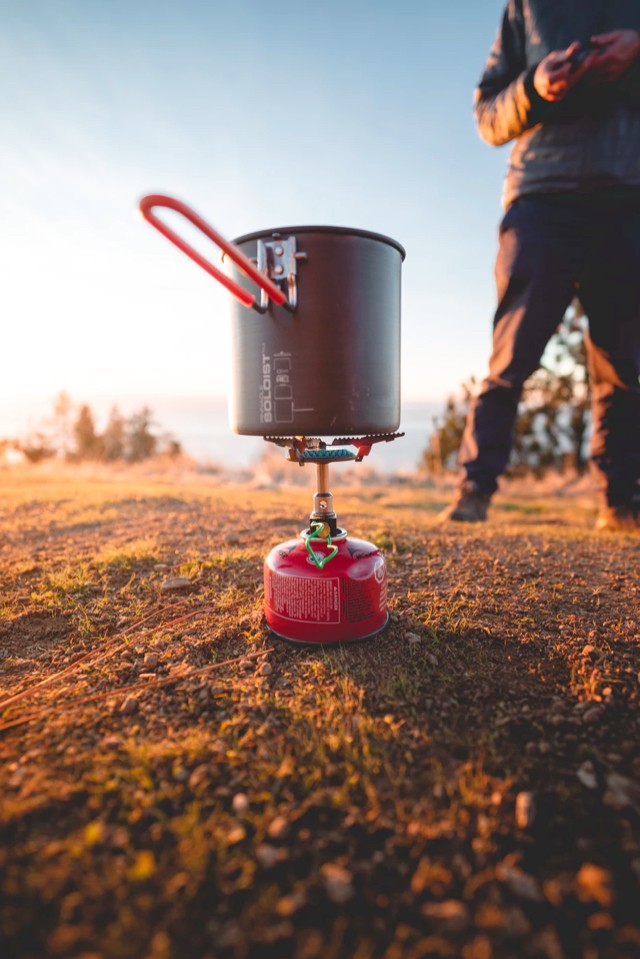
Things break, and while the chances are slim your system is not a 100% fallback – so it’s worth having a backup for those emergency systems. In cases where you’re pump or gravity filter is not working, it’s a great idea to have a backup filter straw (we recommend the LifeStraw) or chemical tablets.
Alternatively, if you’re on a multi-day trip and carrying a portable backpacking stove – then you can boil water and use that for drinking. Boiling will eliminate almost all contaminants and make the water safe. The gas cylinder pictured will only give you about 6 liters of water (12 x 500ml boils) – so it’s not a long term solution for more than one person or day.
Final thoughts
Water filter systems are amazing, they allow us to travel far and wide and give us the ability to safely drink water from rivers and streams without worrying about the potential hazards. Of course, these systems are not foolproof, but you can be pretty confident that they’re taking out 99% of the risk when you head out into the backcountry.
To recap
- Choose a water purifier if you’re going to higher risk areas or drinking from contaminated water.
- Always have a backup life a LifeStraw and/or chemical tablets.
- Always choose the cleanest looking running water.
- Keep your system well-maintained and replace your cartridges as needed.
Have fun and enjoy the mountain trails. I hope this guide helped you decide on the right system for you. If you enjoyed it please give it a share or comment below with any questions you may have.
How Much Water to Drink While Hiking?
Knowing how much water to drink is an important part of planning a backpacking trip. With a water filter, you are better prepared but you’ll still need to carry water to get you safely to your water source.
On an average hike in 20°C (68°F) weather, you should expect to drink 0.5-1 liters (2-4 cups) per hour. In warmer or more humid weather you’ll want to drink more than this.
I cover all the factors around water consumption and the formula I use to plan my hikes on my full post here.
